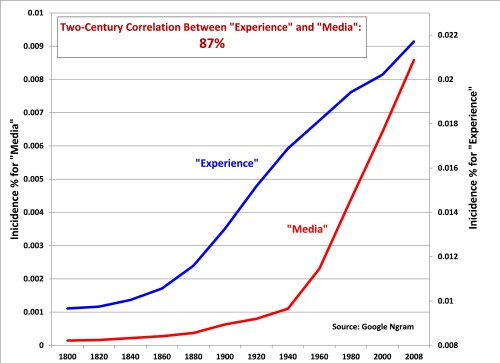The Amplified Experience is Critical to Media Relevance -- Graeme Hutton

All media that fail to offer an enhanced value exchange will soon become spam. While that may be a bold statement to make, we can easily turn to the traditional models of mass media and see how they are faring in today’s world. Mass media are based on old models of communication. If anyone still doubts this, they only have to look at the aggregate declining audiences and revenues of magazines, newspapers and radio over the last ten years. Television’s threat comes in the form of its ageing process. In the last quarter of 2008, the average age of the TV broadcast primetime viewer was 49, in the same quarter last year it was 51. About 50% of TV viewing is now among the over 50s.
All media that fail to offer an enhanced value exchange will soon become spam.
While that may be a bold statement to make, we can easily turn to the traditional models of mass media and see how they are faring in today’s world.
Mass media are based on old models of communication. If anyone still doubts this, they only have to look at the aggregate declining audiences and revenues of magazines, newspapers and radio over the last ten years. Television’s threat comes in the form of its ageing process. In the last quarter of 2008, the average age of the TV broadcast primetime viewer was 49, in the same quarter last year it was 51. About 50% of TV viewing is now among the over 50s.
While these numbers speak for themselves, it’s all too easy to point out the ills of the mass communications channels. The much harder issue is how to reverse these fortunes. And how can we achieve that? I believe the answer lies in a fundamental understanding of the consumer: Who consumers are at the very core of their psyche.
Human characteristics, the world of psychology now largely accepts, can be described across five major dimensions. Referred to as the Five Factor Model, these primordial characteristics are: conscientiousness, extraversion, agreeableness, neuroticism and openness to experience.
The last of these five, openness to experience, is a general appreciation for areas such as emotion, adventure, ideas, imagination, curiosity and variety of experience – the key elements of any quality media encounter. So if we think about how consumers use media, we find that it also aligns with openness to experience. Media, in all its forms, brings consumers experiences in the form of information, entertainment, education and stories. It also implies that media appear to have a direct link with human beings’ five elemental characteristics.
Two-Century Correlation Between Experience And Media
We can gauge the relative importance of experiences and media and their relationship to one another over time by using Google Ngram. Google Ngram tracks the use of a specific word in the English language where we can quantify the growth or decline of that word over the last two centuries. For example, the word television started to gain traction in usage in the mid-1920s, around the time it was invented, and it is currently at an all-time high. By contrast, usage of the word newspaper peaked in 1938, and has since declined by -24%.
By comparison, if we chart the incidence of the two words media and experience in the English language, they exhibit a very positive correlation of 87% (where 100% would be a perfect alignment, and 0% would indicate a zero relationship):

We can see that as experience has grown so has media, taking off in the 1950s and continuing a steady climb. Media that recognize consumers’ growing thirst for experiences can thrive in this environment. For instance, while TV audiences may be ageing, look at how TV electronics are continually reinventing themselves (e.g. HDTV, 3-D, 4K, Smart TVs, etc.). Computers are also shifting their experiential form from desktops to laptops to tablets. Similarly, cell phones have metamorphosed into smartphones which, in turn, also keep reinventing themselves (e.g. tablets, Siri, Google Now). Clearly the consumer need for an enhanced experience continues to grow.
The Advertising Platform Formerly Known as Mass Media
Advertising communications channels have always offered their audiences a value exchange. For instance, TV provides entertainment experiences in return for advertising and indirectly a cable fee, magazines present an edited cornucopia of material on a selected topic in return for a cover price and advertising. Social media and digital advertising are currently testing the limits of their value exchanges by expecting consumers to provide specific information about themselves or their behaviors, which the digital properties can subsequently leverage in targeted advertising.
TV, print, radio, etc. have always needed to provide consumers with a value exchange, but now younger consumers’ growing sense of entitlement gained in the digital world (where information was often offered at low or zero cost) is shifting across all channels.We only have to look at the emergence of TV cable cord-cutters or the growth of services such as Bit Torrent for evidence of this. Bit Torrent has increased its audience by over +70% in the last two years to a monthly audience of 23 million users.
If a media channel doesn’t offer an enhanced array of fresh new experiences to reinforce its value exchange, it will be potentially regarded as spam. The only way mass media can respond to this is either by a) reducing their direct costs to consumers or the advertising load or b) increasing the depth and variety of experiences.
How can a communications channel do this? To start, by actively embracing all new media forms to extend the experiences they offer consumers. These experiences must be enhanced to include a variety of elements such as second screen interactions, more original and higher grade content, increasing the non-linear viewing opportunities and identifying with core audiences on an ever-closer and more relevant basis. Some may also have to consider ways to reduce their ad loads. While US consumers seem relatively happy with TV ad loads, that isn’t necessarily borne out in the digital world, which is inevitably where video viewing will migrate. For example, studies by our research arm, Magna, indicate that ad clutter appears to undermine TV effectiveness by up to -25% compared to digital video alternatives.
If you are still looking for confirmation of the increasing closeness between the terms media and value exchange, consider this: Google NGram indicates the correlation between the words media and value exchangeover the last two centuries is a breathtaking 99%! That is testimony indeed.
Graeme Hutton is SVP, Group Partner, Research at UM. Graeme came from the UK to the US in the late 90s, and his only regret is that he did not do it sooner! Graeme joined UM in 2006. At UM, he has engineered and activated a broad-based set of integrated communications and consumer insight tools which dovetail in to the agency’s burgeoning arsenal of media research products and systems. His key clients include Sony Pictures Entertainment and Sony Electronics. Graeme can be reached at Graeme.hutton@umww.com
late 90s, and his only regret is that he did not do it sooner! Graeme joined UM in 2006. At UM, he has engineered and activated a broad-based set of integrated communications and consumer insight tools which dovetail in to the agency’s burgeoning arsenal of media research products and systems. His key clients include Sony Pictures Entertainment and Sony Electronics. Graeme can be reached at Graeme.hutton@umww.com
Read all Graeme's MediaBizBloggers commentaries at Curious Thoughts from Curious Minds.
Check us out on Facebook at MediaBizBloggers.com
Follow our Twitter updates @MediaBizBlogger
The opinions and points of view expressed in this commentary are exclusively the views of the author and do not necessarily represent the views of MediaBizBloggers.com management or associated bloggers. MediaBizBloggers is an open thought leadership platform and readers may share their comments and opinions in response to all commentaries.


